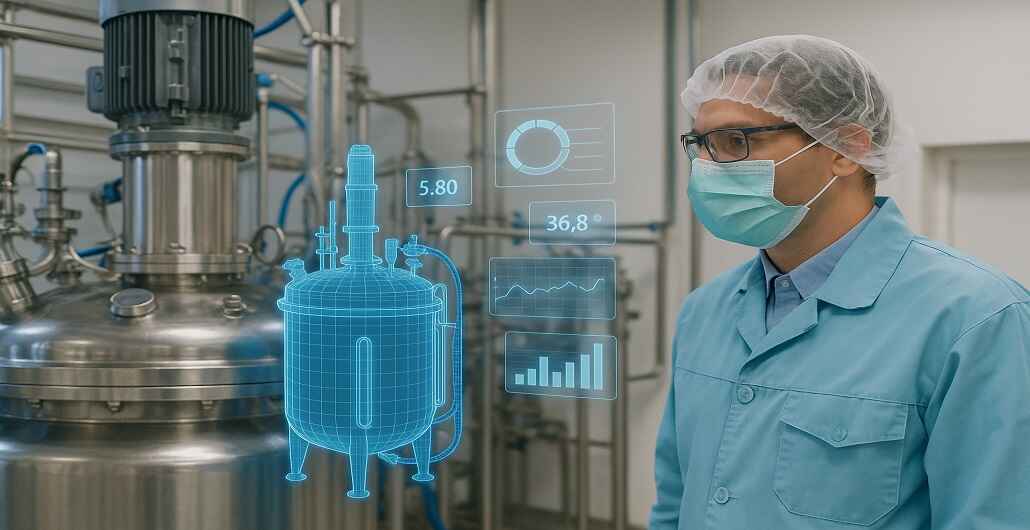The biopharmaceutical industry has been a leader of technology adoption to increase efficiency, maintain safety, and provide innovations that change the practice of care. Over the past few years, the rise of digital twins in biopharmaceutical manufacturing has been one of the most transformative advancements across the industry. Not just a buzzword, these digital twins symbolize a paradigm shift in designing, monitoring, and optimizing biopharma operations. With the help of AI (artificial intelligence) and real-time data, digital twins are poised to elevate industry standards, providing previously unimaginable accuracy, efficiency, and scalability.
What Are Digital Twins?
Digital Twin (DT) (digital twin): a digital model, with ongoing updates and interactions, of a physical system. Digital twins, in contrast to traditional models, are dynamic, constantly processing information from their physical counterparts through sensors and connections via the cloud. This allows them to model, predict, and optimize dynamic processes in a way that classical static models fail to achieve.
For example, within a biopharmaceutical environment, a digital twin of a bioreactor might incorporate live data on temperature, pH and the use of raw materials. These types of metrics can be used by the digital twin to replicate the behavior of the physical reactor and support robust scenario analyses, predictive maintenance, and more effective process control. What’s more, digital twins are not restricted to isolated processes, but instead can be deployed across different systems at once to provide a comprehensive view of manufacturing operations.
Why Digital Twins are Needed in Biopharma
These complexities pose unique challenges, and the biopharmaceutical industry is adapting to: personalized medicine, fewer experienced scientists, and increasing regulatory body expectations. Digital twins offer a powerful opportunity to confront these challenges directly. By leveraging real-time data and advanced analytics, DTs help manufacturers to:
- Minimize inefficiencies and waste.
- Optimize production processes and quality control.
- Mitigate risks through predictive maintenance.
- Shorten development timelines for life-saving therapies.
In this game of speed and precision, digital twins have become a vital weapon in the arsenal of companies chasing excellence.
Important Applications in Biopharmaceutical Production
Digital twins in biopharmaceutical manufacturing are protecting multiple stages in early research and development to production and quality assurance. AI is one of the most revolutionary elements as it can significantly upgrade digital twins by giving them the ability to produce actionable insights, to predict results, or to make real-time adjustments in manufacturing.
Enhanced Process Optimization
Predictive and prescriptive analytics can enhance biopharmaceutical processes, and digital twins enable such analytics. For example, a DT can model multiple manufacturing scenarios to identify the most suitable parameter settings to generate a high-yielding batch of monoclonal antibodies. The system can recommend tweaks to temperature, nutrient levels, etc, depending on information gleaned from a sub set of sensors in the bioreactor, etc, the effect of which delivers the highest yield of cell growth in terms of productivity.
Testing and Verification of Quality and Risk
One of biopharma’s most notable challenges is ensuring that product quality is consistent across all batches. Digital twins do this by acting as virtual quality assurance agents. Real-time sense-making enables them to detect anomalies at each step of the production process and make recommendations before slight misalignments turn into costly mistakes.
This feature is especially handy when it comes to risk mitigation. For example, if a digital twin detects a potential contamination incident from sensor data, corrective actions can be taken immediately, saving production downtime or product recalls.
Predictive Maintenance
Similarly, digital twins are also vital to equipment maintenance. Through analyzing historical performance data and real-time conditions, they can anticipate when machines are likely to break down or need servicing. This predictive maintenance strategy goes beyond reducing unplanned downtime to also increasing the lifespan of expensive manufacturing equipment.
Revolutionizing R&D Speed to Market
And it isn’t just in manufacturing — digital twins are also making a splash in research and development. Harnessing historical data with AI-assisted insights, DTs can simulate complex biological processes, expediting the exploration of new drug candidates. This is especially transformative in areas like precision medicine, where rapid iteration and experimentation are vital.
Role Of Advanced Technologies In AI-Driven Digital Twins
The Fourth Industrial Revolution, characterized by the emergence of advanced technologies such as the Internet of Things (IoT), artificial intelligence (AI), and cloud computing, has allowed for the complete manifestation of digital twins in biomanufacturing. I encourage with the fact that powered by massive datasets, patterns and propose novel solutions AI algorithms are also very interesting division for DT.
For example, AI-enhanced digital twins can conduct counterfactual analyses, such as hypothetical simulations that attempt to answer what would have happened under different conditions. It enables manufacturers to run simulations of different scenarios without the need for expensive physical testing. Moreover, AI makes sure to ban human bias in process refinement, which means that decisions are based solely on factual data.
The Data – Driving Digital Twins
The quality and amount of the data are vital for the success of digital twins. Biopharma companies produce thousands of terabytes of data each year, but up to 70% of this information is frequently left untapped. The digital twin can only realize its full potential when organizations implement strong policies regarding data governance so that data is not just open but trusted and timely.
Cloud technologies are proving to be the solution to a lot of data problems. The cloud provides digital twins with the secure storage and real-time data processing capabilities needed to be operational at their full potential. Moreover, the growing prevalence of sensors to provide real-time parameter monitoring of complex processes has improved data collection, with high dimensionality features, for DTs and advanced their precision.
Challenges and Considerations
As promising as digital twins are, there are challenges to adoption. Organizations need to grapple with problems such as:
The importance of securing biopharmaceutical data from cyber threats is imperative.
- Data Security: Protecting sensitive biopharmaceutical data from cyber threats is critical.
- Regulatory Compliance: Ensuring that digital twin applications meet rigorous industry standards.
- Integration Complexity: Seamlessly integrating digital twins into existing manufacturing systems can be a daunting task, requiring significant investment in infrastructure and training.
The Road Ahead
The use of digital twins will likely grow in biopharmaceutical manufacturing as these essential tools develop and mature. This technology has tremendous potential to revolutionize emerging fields such as gene therapy as well as personalized medicine and AI-based drug discovery. For that reason, the challenges posed by transactions will continue to be addressed effectively with digital twins, while the increasing prevalence of advanced analytics and IoT devices will help make them even smarter still, increasing accuracy and efficiency.
Conclusion
The emergence of digital twins in biopharmaceutical manufacturing signifies a revolutionary advancement in the sector. These virtual counterparts leverage real-time data, AI, and advanced analytics to unleash the potential for process optimization, risk mitigation, and innovation like never before. The big picture for digital twins is undoubtedly an encouraging one, even though several challenges must be overcome. The world of manufacturing going forward won’t just be determined by speed and scalability as biopharma organizations continue to adopt this leading edge technology, but ultimately, by precision and predictive ability. Welcome to the era of digital twins — and its revolutionary impact on biopharmaceutical manufacturing.


















